Path of Exile 2 Racing Explained: Full Guide, Events & Strategies
Updated On: November 12, 2025 by Aaron Connolly
Race Event Structure and Objectives
Path of Exile 2 race events use a Standard Solo Self-Found format. Players compete to beat Doryani in Act 3 as fast as they can.
Each race sticks to fixed layouts, so everyone gets the same shot. The joining process is pretty simple, but the mechanics change up from normal gameplay in a few key ways.
Joining Path of Exile 2 Race Events
Jumping into a Path of Exile 2 race? It’s not complicated, but you do need to be quick. On the Character Select screen, you’ll see a “Join” button pop up when registration opens.
Race events run on set dates. The first official races kicked off in March 2025, usually on weekends.
Key joining requirements:
- Make a fresh character for each race.
- No entry fee.
- Both PC and console players can join.
- You can’t pre-level or prep characters in advance.
After you join, your character chills in a lobby until the synchronized start. Miss the start? Too bad—there’s no catch-up, and everyone begins together.
Heads-up: If your character name is offensive—even if it’s sneaky—you’ll get disqualified on the spot.
Race Mode Rules and Unique Mechanics
Path of Exile 2 races stick to Standard Solo Self-Found (SSF) rules, but add some twists. You can’t trade or get help from anyone else during the event.
The biggest change is the fixed layout system. Unlike regular play, race maps are always the same.
Core race mechanics:
- No trading or party play.
- Fixed map layouts for Acts 1-3.
- Dying costs you a big chunk of time.
- Real-time leaderboards show who’s ahead.
- When the race ends, your character moves to a Remove-Only stash tab.
Most race characters go straight to the Void league after the event. You lose the character, but you get to keep any rewards you picked up.
Fixed layouts add a real strategic layer. You can memorize routes and plan ahead, so practice runs really matter.
Objectives: Defeating Doryani and Progression
The main goal in Path of Exile 2 races? Be the first in your class to kill Doryani in Act 3.
Doryani is the big boss at the end of Act 3. The fight always happens in the same spot, with the same mechanics every time.
Progression requirements:
- Clear Acts 1 and 2.
- Find Doryani in Act 3.
- Beat the boss to lock in your finish time.
- Fastest player per class wins the Demigod item.
Strategic considerations:
- Speed vs safety: Go too fast and you might die.
- Gear priorities: Survivability usually beats pure damage.
- Route optimization: Learn the quickest paths.
- Resource management: Don’t blow all your flasks or run out of mana.
Each of the six classes has its own leaderboard. You’re only racing against people using the same class.
Quick tip: Run through Acts 1-3 in Solo Self-Found mode before race day. You’ll spot trouble spots and get a feel for the best routes.
Race Schedule and Participation
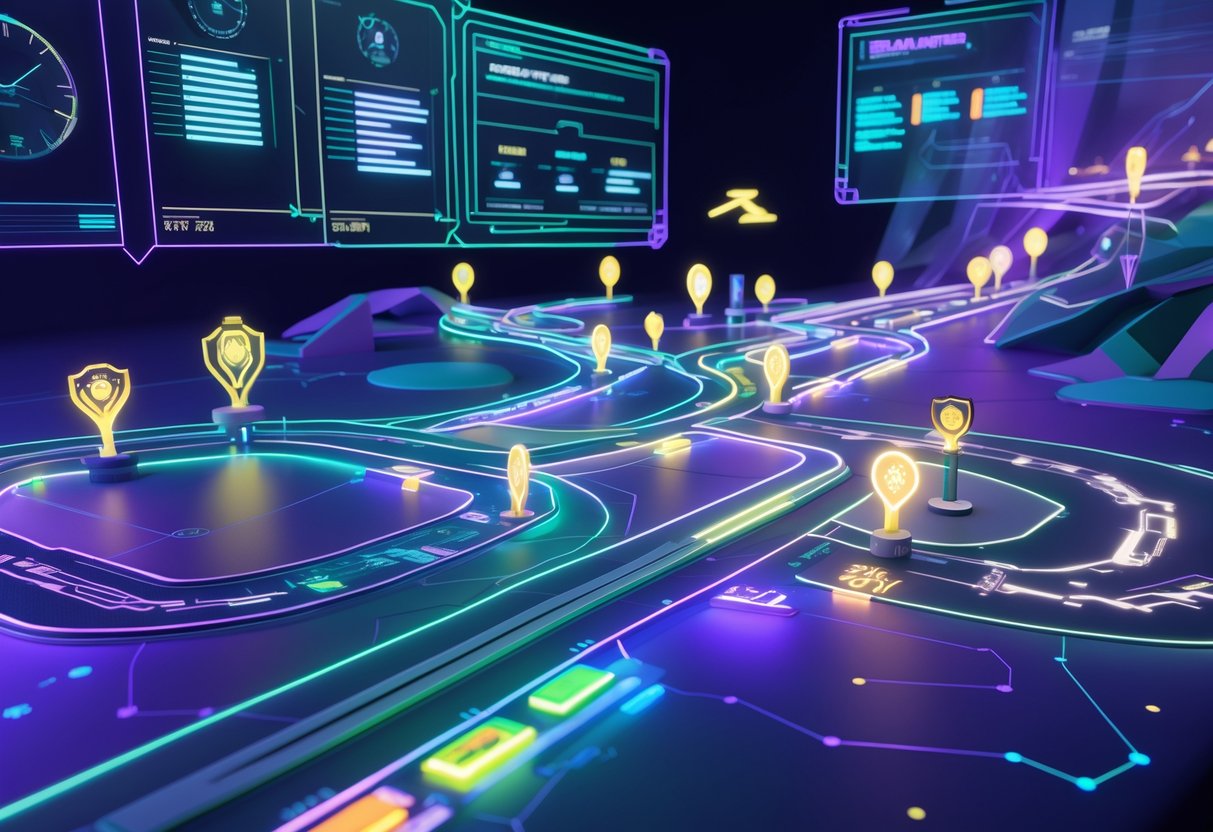
The first Path of Exile 2 race events kicked off in March 2025. There were three separate competitions, all about beating Doryani in Act 3 as fast as possible.
These races are free and open to both PC and console players during early access.
Race Dates and Time Zones
Grinding Gear Games set up three races throughout March 2025. Each one follows the same rules, so you get multiple shots.
Race Schedule:
- Race 1: March 2nd, 2025 at 11:00 AM PST
- Race 2: March 9th, 2025 at 11:00 AM PST
- Race 3: March 16th, 2025 at 3:00 PM EST
The time zone switch for the third race tripped up a few folks. The first two races used Pacific time, then the last one jumped to Eastern.
Quick tip: Set a calendar reminder in your own time zone. If you’re late, you can’t make up lost ground.
All participants start at the same time, everywhere. There’s no staggered start—everyone races together.
How to Participate and Registration Steps
Joining a Path of Exile 2 race is pretty painless. You don’t need to register outside the game or pay anything.
Registration Process:
- Open Path of Exile 2 on PC or console.
- Go to the Character Select screen.
- Watch for the “Join” button when registration opens.
- Click “Join” to sign up.
- Make a new race character (no existing characters allowed).
The “Join” button usually shows up a few hours before the race. It’s best to sign up early, just in case.
Race Character Creation:
- You must make a fresh character for each race.
- Pick any of the six classes.
- Your main game progress doesn’t affect race characters.
- Race characters live in a separate league.
All races use Standard Solo Self-Found (SSF) mode. So, no trading or teaming up.
Entry Requirements and Eligibility
Most people can join Path of Exile 2 races, but there are a few ground rules.
Basic Requirements:
- You need Path of Exile 2 Early Access (PC or console).
- Stay connected to the internet.
- Pick a character name that won’t get you in trouble.
Eligibility Restrictions:
- GGG staff can’t win prizes.
- Alpha testers can’t win either.
- Offensive names mean instant disqualification.
Fair Play Rules:
They check character names for anything offensive. Don’t try to sneak something in—if it’s even a little questionable, you’re out.
Prize Eligibility:
Each race hands out six Demigod items—one per class. Only the fastest player for each class gets a prize. The March 16th race also gives out an Alienware m16 R2 laptop.
Winners get their Demigod items in a Remove-Only stash tab, which you can move to your main leagues. If you win more than once, you can collect different pieces of the Demigod set.
Rewards, Prizes and Leaderboards
Race events offer exclusive prizes you can’t get anywhere else. The top reward is an Alienware gaming laptop, but class-based prizes mean everyone has a shot at something cool.
Demigod’s Virtue and Unique Items
Demigod items are the most sought-after rewards in Path of Exile 2 racing. Each race gives out six Demigod’s Virtue items—one for each class.
These items make up the Demigod armour and weapon set. If you manage to win more than once, you can collect more pieces.
You only compete against players using your class, so it feels fair.
After each race, winners find their prizes in a remove-only stash tab. You can move these items to your main characters.
Quick tip: Stick with one class and master it. You’ll have a better shot at racking up multiple Demigod pieces.
Leaderboard Tracking and Prizes
Real-time leaderboards let you see where you stand as you play. You can keep an eye on your ranking and maybe adjust your strategy if you’re falling behind.
The leaderboard tracks how fast you defeat Doryani in Act 3. Every second really does matter.
Organizers post links to live leaderboards before each event. You can watch the competition as it happens.
Heads-up: If you die, you get a one-minute penalty on your final time. That’s enough to cost you the win.
Results show up as soon as the race ends. Winners get a notification in-game and through official announcements.
Alienware m16 R2 Grand Prize
The Alienware m16 R2 gaming laptop is the big-ticket prize. It’s got some serious specs.
Specs:
- Intel Core Ultra 7 processor
- NVIDIA GeForce RTX 4070 graphics
- 32GB RAM
- 1TB SSD
- Windows 11 Home
Only one laptop goes out per race series. Whoever posts the fastest overall time wins this grand prize.
This laptop is aimed at hardcore players who want the best gear. It’ll run Path of Exile 2 at max settings, no sweat.
Honestly: The laptop prize adds a ton of pressure at the top. Even casual racers push a bit harder when there’s real hardware on the line.
Playable Classes and Their Racing Strengths
Path of Exile 2 racing revolves around six main classes. Each has its own movement tricks and damage options, which really affect how fast you can go.
Recent race data puts Warrior at the top thanks to crazy mobility. Sorceress, on the other hand, lags behind because of early-game struggles.
Core Classes: Warrior, Witch, Ranger, Mercenary, Monk, Sorceress
Warrior is the king of racing right now. Shield Charge and Leap Slam together make you fly through maps. Bone Shatter with Seismic Cry melts bosses.
Warriors can skip sketchy fights with their high armor and block. That tankiness saves time and keeps you moving.
Monk sits comfortably in second place, but there’s a gap. Ice Strike gives great area damage, and the Double Bell combo helps with tougher mobs.
Monks share some movement skills with Warriors, but they’re just a little less slick. Their attack speed passives do help close the gap a bit.
Witch actually does better than people expect. Demon Form gives a big movement speed boost. Contagion spreads damage through packs.
Flame Wall and Raging Spirits help clean up leftovers. Demon Form’s tankiness lets you stay aggressive.
Ranger clears well but lacks good movement skills. Lightning Arrow shines early on, and Shattering Concoction ramps up later.
Pathfinder ascendancy keeps your flasks up longer, but not having active movement skills slows things down.
Mercenary brings solid area damage with grenades. Crossbow shots are reliable for ranged fights, and Adrenaline Rush gives a quick speed burst.
Still, Mercenary just doesn’t have the mobility of other classes. Grenades clear fast, but moving quickly is the real issue.
Sorceress struggles the most in races. Lightning Nova works for clearing once you get going, and Ice Shard adds some crowd control.
But early on, she’s squishy and needs good gear, making speed runs tough. Not having strong movement skills doesn’t help either.
Class-specific Strategies and Metas
The Movement-First Approach really defines how top racers play. We go after Shield Charge and Leap Slam before worrying about damage upgrades. Swapping weapons between movement and damage setups just makes everything smoother.
Warriors tend to carry both shield-and-weapon combos for moving fast and two-handers for bosses. That flexibility? It’s what sets the best racers apart.
Area Damage Scaling matters a ton for clearing packs. Ice Strike, Contagion, and Lightning Arrow all wipe out groups at once. We skip single-target skills early on—they just slow you down.
Monks get the most out of rotating Ice Strike and Frost Bomb. This way, you keep your damage rolling while moving through each zone.
Boss Burst Strategies are what separate the good from the great. Prepping Seismic Cry before big fights saves surprising amounts of time. Perfect Strike lands those critical hits exactly when you need them.
Here’s a quick win: practice swapping weapons for movement and damage before race day. Those smooth transitions? They add up, turning seconds into minutes across a whole run.
Witch players should keep Demon Form up as much as possible. The speed boost is worth the resource drain, especially when every second counts.
Passive vs Active Movement is where the big gaps show up. Classes with active movement (like Warrior and Monk) just leave passive-speed classes (Ranger, Mercenary) behind.
Heads up: Sorceress isn’t beginner-friendly. She demands flawless execution and deep game knowledge. If you’re new, maybe skip her at first.
Game Mechanics Relevant to Races
Knowing how Path of Exile 2’s systems work during races can totally change your results. Death penalties hit hard—you’ll lose a whole minute. But if you master movement skills and boss fights, you’ll have a real shot at winning.
Movement Skills and Route Optimisation
Sprint is your best friend for getting from fight to fight. Every class starts with it, but managing your spirit (yep, that’s the sprint resource) gets tough on longer stretches.
Each class brings its own tricks for moving fast. The Ranger picks up dodge rolls and mobility gems early. The Monk chains movement into attack combos. Warriors might look slow, but their charge skills close gaps fast.
Route planning really matters since race maps are fixed. Practice the Doryani path a bunch before the big day. Ignore optional quests unless they give you movement upgrades or must-have gems.
Key movement priorities:
- Learn where waypoints are in each act.
- Figure out which side areas to skip.
- Memorise monster pack spots to dodge extra fights.
- Use terrain like ledges and doorways to your advantage.
Race Penalties and Death Mechanics
Die in a Path of Exile 2 race, and you eat a nasty one-minute penalty. That’s usually game over for your run. So, defensive planning matters as much as speed.
Go for life rolls on gear before pure damage. Resistances matter before bosses—even grabbing some quick resist gear can save you from a race-ending death.
The penalty timer kicks in the second you die. You’ll respawn at the closest checkpoint, but losing a minute usually means someone else hits Doryani first.
Survival strategies:
- Always carry life flasks and refill them often.
- Don’t fight rogue exiles unless you have no choice.
- Level up before bosses if you’re behind.
- Use doorways to break line of sight with tough enemies.
Boss Encounters and Rogue Exiles
Boss fights between Acts 1-3 can make or break your run. Every boss has its own tricks, so you need to learn them for quick kills.
Doryani, the final boss, comes with multiple phases and all sorts of attacks. Positioning well saves time and prevents deaths. Practice this fight—a lot. It’s where most races are decided.
Rogue exiles show up randomly and can get really dangerous. They use player-style skills and can kill you fast if you’re not ready. Most experienced racers just skip them unless they’re blocking a key spot.
Boss encounter tips:
- Find safe spots in each boss arena.
- Bring damage types that counter each boss.
- Skip looting after kills—just grab what you need and go.
- Watch video guides of top racers to learn their boss strats.
Equipment and Items for Optimal Racing
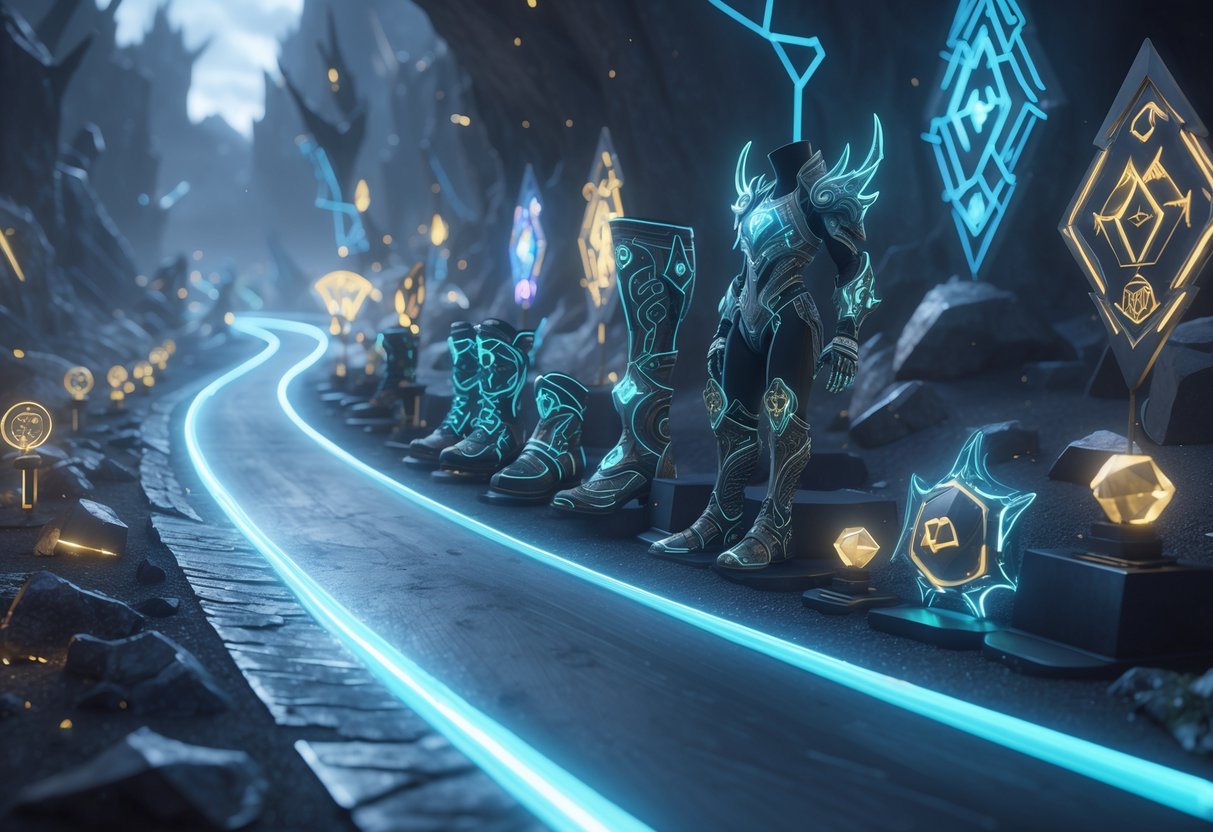
Picking the right gear can shave minutes off your time. You want to balance movement speed, damage output, and survival—without grabbing stuff that slows you down.
Weapons and Gems for Speed
We go for weapons with high base damage instead of fancy stats. Often, a simple two-hander beats a complex one-handed setup because it needs fewer support gems to work.
Movement gems are non-negotiable. Dash and Evade should be your first picks. These let you skip fights and move faster than just running.
For damage, area-of-effect skills clear packs quickly. Single-target skills just waste time when you need to keep moving.
Weapon swapping gets important in later acts. Keep a ranged weapon for pulling and a melee for close-up combat. This way, you won’t get stuck in bad spots.
Support gems that boost movement speed or cut mana costs are better than pure damage. Waiting for mana to refill burns precious time.
Essential Armour Choices and Sockets
Boots with movement speed are the most important piece of armour you’ll find. Even a small 10% speed boost adds up over a full race.
We pick armour with the right socket colours over high defence. Linking your key gems matters more than a few extra armour points.
Belts should focus on resistances and life. Flask bonuses on belts help your potions last longer in tough fights.
Chest armour just needs enough sockets for your main skills. A 4-link chest with the right links beats a 6-socket with bad links any day.
Skip heavy armour unless you desperately need the defence. Speed almost always wins out in races.
Role of Uniques in Races
Unique items can change your build, but you can’t count on them dropping. Never plan your whole run around getting a specific unique.
Movement uniques—like boots with teleports or speed—are amazing if you find them. They give you stuff rares just can’t.
Some unique weapons bring special attacks or gem combos that clear enemies super fast. If you find one that fits, equip it.
Don’t get distracted by uniques that don’t help your goals. That cool unique helmet? If it doesn’t make you faster or safer, it’s just slowing you down.
Check uniques between fights, not during. Stopping mid-combat to read item descriptions wastes time you can’t get back.
Strategies from Top Racers

The fastest Path of Exile 2 racers all use similar tricks. They focus on movement, weapon swaps, and builds that favour speed over tankiness.
Optimising Your Run and Pathing
Shield Charge rules movement in winning runs. Every top racer keeps a shield ready for mobility, even if their main weapon is a two-hander.
Weapon swapping is a must. Racers equip shields for moving, then swap to two-handers for bosses and tough fights.
Combining movement skills saves the most time. Mr. Angoras, for example, alternated Leap and Shield Charge to keep up constant speed. Warriors picked up this trick fast.
Map knowledge is a big deal. Top racers either memorise layouts or spot patterns quickly. They even timestamp their own runs to improve routes.
Death management sounds weird, but sometimes dying on purpose saves time. Taking the one-minute penalty can be worth it if it means skipping a tough boss or dangerous area.
Act 1 gets the most practice. Your core gear and skills come from here, and a bad start usually means you just restart.
Veteran Tips and Meta Shifts
Early trade isn’t an option in race events—everything is Solo Self-Found. So, you need to get good at vendor shopping and picking items on the fly.
Check vendors often. Magic gear with movement or attack speed can give you a big edge. We suggest checking after each level-up in Acts 1 and 2.
Knowing item bases is huge. After racing the same class a few times, you’ll know which bases matter in a short race.
The meta changed after the first races. Warriors with Bone Shatter builds crushed it, while sorceresses had a tough time. This shifted which classes people picked next time.
Fixed layout zones are gold for top racers. You can memorise the route perfectly. Random zones? You’ll need to adapt and spot patterns on the fly.
Timing matters more than most think. Veterans track their checkpoints to see where they’re losing time.
Recommended Builds for Speed
Warrior builds lead the current meta. Mr. Angoras’ winning setup used Bone Shatter for main damage and Seismic Cry plus Perfect Strike for bosses. It’s fast and hits hard.
Monks are solid too. Sarge’s Ice Strike Monk finished an hour behind the top warrior, using Contagion early and Ice Wave with Frost Bomb for bursts.
Witch builds surprise a lot of people. Infernal’s best Witch run used Contagion instead of minions. He combined Flame Wall and Gas Cloud for poison, then switched to Demon Form in Act 2.
| Class | Best Time | Key Skills | Movement Method |
|---|---|---|---|
| Warrior | 2h 28m | Bone Shatter, Seismic Cry | Shield Charge + Leap |
| Monk | 3h 30m | Ice Strike, Contagion | Shield Charge + Leap |
| Witch | 4h+ | Contagion, Flame Wall | Demon Form mobility |
Ranger and Sorceress builds aren’t keeping up right now. Fastest Sorceress still took over 4 hours. Lightning Rangers who switch to Shattering Concoction do better than pure bow builds, but there’s work to do.
Technical Details, Platforms and Requirements
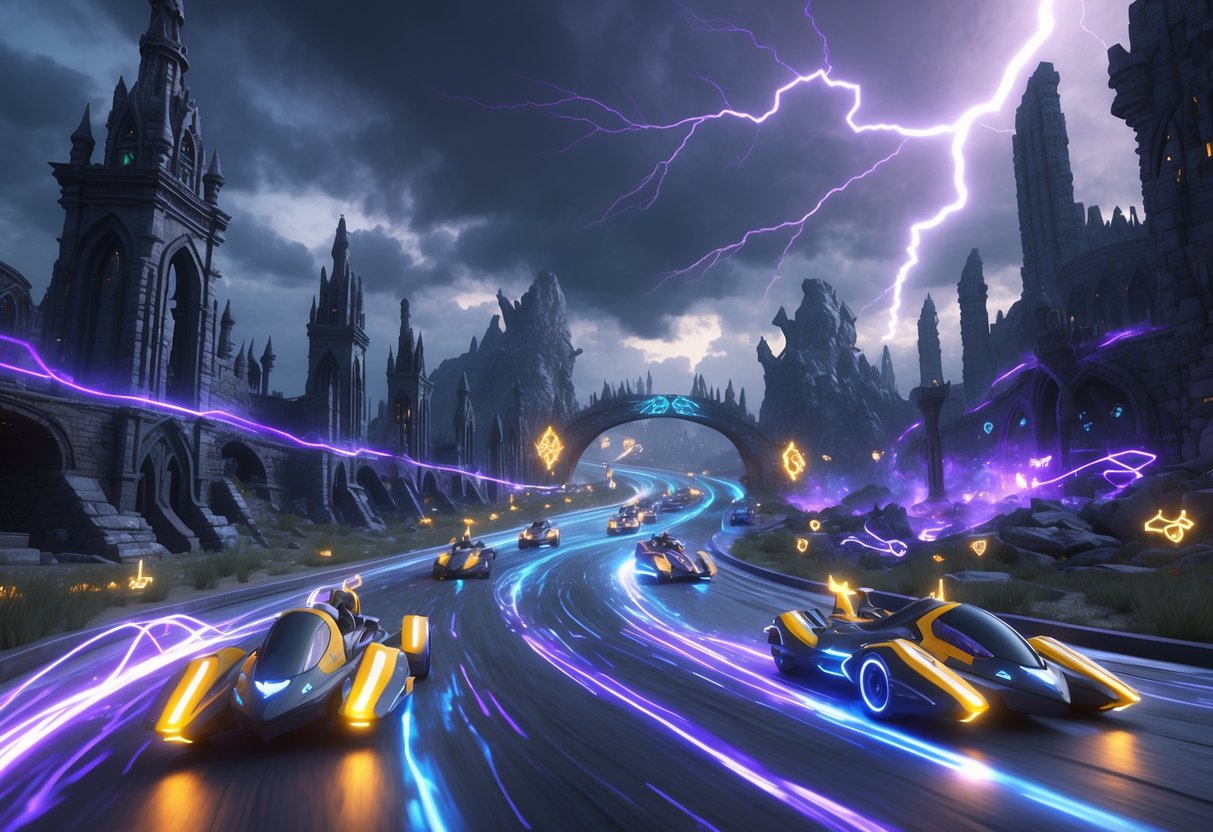
Path of Exile 2 needs more hardware than the first game, especially if you want smooth performance in races. You can play cross-platform on PC and consoles, with dedicated servers for competitive events.
PC Requirements and Performance Tips
Path of Exile 2 asks for decent specs. The minimum is 8GB RAM, but you’ll want 16GB for racing.
Minimum PC Requirements:
- Processor: Intel i5-4430 or AMD equivalent
- Memory: 8GB RAM
- Graphics: GTX 1050 or RX 560
- Storage: 100GB available space
Recommended for Racing:
- Processor: Intel i7-8700K or Ryzen 5 3600
- Memory: 16GB RAM
- Graphics: RTX 3060 or RX 6600 XT
- Storage: SSD with 100GB space
Smooth frame rates are key. If your system struggles, cap FPS at 60.
Turn off particle effects and shadows for better performance. Most racers stick to medium settings for 120+ FPS during busy moments.
Performance Tips for Racers:
- Close background apps.
- Use fullscreen, not windowed.
- Turn off Windows Game Mode.
- Keep graphics drivers updated.
Console and Cross-platform Support
Path of Exile 2 lands on PlayStation 5 and Xbox Series X|S at the same time as PC. You can race against friends no matter what platform they’re on, thanks to cross-platform play.
Console racers jump into the same servers as PC players. Your progress and characters follow you everywhere through your account.
Platform Features:
| Platform | Cross-play | Performance | Racing Events |
|---|---|---|---|
| PC | Yes | Up to 120+ FPS | Full support |
| PS5 | Yes | 60 FPS target | Full support |
| Xbox Series X | S | Yes | 60 FPS target |
Controllers work everywhere, but a lot of console racers love using them for movement. Still, inventory management feels slower than with a keyboard, and that’s a common complaint.
The racing community stays together across platforms. Leaderboards pull everyone into a single ranking, so it’s a true competition.
Path of Exile 2 Servers and Connectivity
Dedicated servers run Path of Exile 2 racing events. Server stability really matters when thousands pile in at once for big races.
The game connects you to global servers, but picks the closest region for the best ping. UK players usually end up on European servers.
Server Regions:
- Europe (Frankfurt, London)
- North America (Texas, California)
- Asia-Pacific (Singapore, Japan)
- South America (São Paulo)
Expect higher latency if you join during peak hours. It’s smart to test your connection before a big race kicks off.
Update 0.3.0 improved server performance for racing. The devs added better load balancing, so league starts don’t crash the servers as often.
Connection Requirements:
- Stable broadband internet
- 50+ Mbps recommended for racing
- Wired connection beats WiFi for stability
- Port forwarding can help if you have issues
Server maintenance usually happens late at night or early morning. They plan race schedules around downtime to avoid messing up events.
Updates, Bug Fixes and Patch Notes
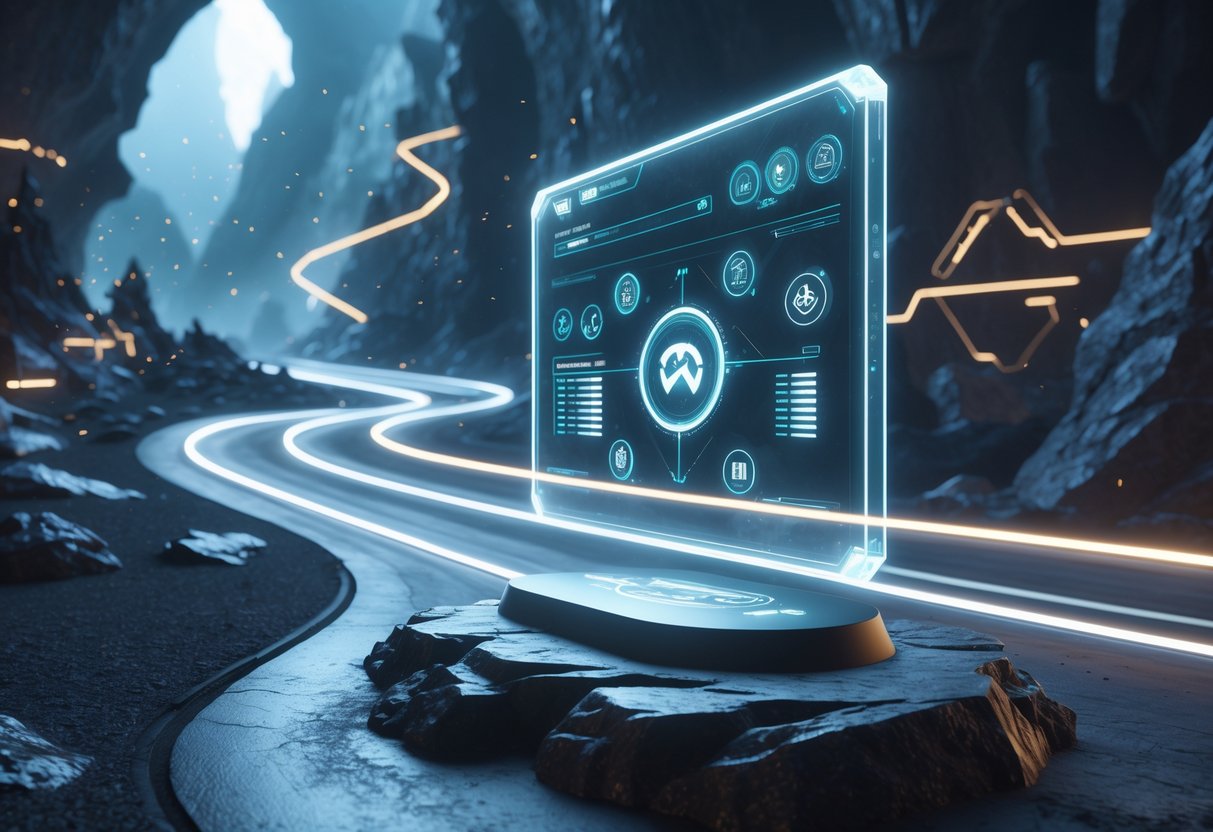
Every patch cycle shakes up Path of Exile 2 racing. Recent updates took out animation cancels and cut down on player mobility. Big content patches often add new mechanics that change how competitive play works.
Recent Race-Related Updates
Patch 0.2.0h changed racing mechanics in a big way. Animation cancels for Rake and Whirling Slash disappeared. This slows down movement, which used to be a big deal for fast racers.
A lot of top racers relied on those cancels for speed. Now, everyone races on a more even field, but the pace feels a bit slower.
Update 0.3.0 “The Third Edict” brought a flood of balance changes. They removed support gem restrictions, so you can stack the same support gem multiple times. That opens up new build options for racing.
The update also added:
- 11 new support gems
- 40 Lineage supports for endgame
- Multiple tiers for existing supports
New skill gems like Fortifying Cry, Forge Hammer, and Toxic Domain have arrived. These shake up the racing meta quite a bit.
The Rise of the Abyssals league introduced mechanics like fissures and abyssal encounters. Racers now have to plan their routes differently.
Notable Bug Fixes: Known Issues
Recent patches knocked out several critical bugs. The town portal bug used to let players shortcut races, but that’s patched now to keep things fair.
Guild donation bugs used to mess with team coordination in group races. Hotfixes cleaned up most of those sync issues.
The Titan’s Treasure bug gave some racers an unfair edge in certain formats. Multiple hotfixes have closed that loophole.
Controller and UI improvements made console racing smoother. Update 1.040 focused on enemy mercenary damage and item interaction glitches.
Challenge tracking works again after being broken for a while. Racers can finally keep tabs on their progress during events.
Still, not everything’s perfect. The Tinker’s Tool bug sometimes delays crafting, which can throw off racing plans. Grinding Gear Games is still working on a fix.
Upcoming Features from Announced Patches
Future patches should address leftover animation quirks. We’ll probably see more mobility skill tweaks based on racer feedback.
The Well of Souls mechanic from patch 0.3.0 is getting more changes. This system affects crafting and waystone mods in endgame races.
Act Four’s non-linear design could shake up future race formats. With eight islands to choose from, organizers have a lot to experiment with.
New currency orbs like Greater Orb of Transmutation will change how racers craft gear. These drop in late campaign and maps, so longer races will feel their impact.
Lineage supports are still endgame-only. The devs might adjust their availability or power if balance gets out of hand.
Blackflame Covenant and other new keystone passives could get nerfed soon. Early race data shows some combos are just too strong.
Support gem wording keeps getting clearer every patch. That helps prevent weird exploits and confusion during races.
Streaming, Community and Twitch Drops
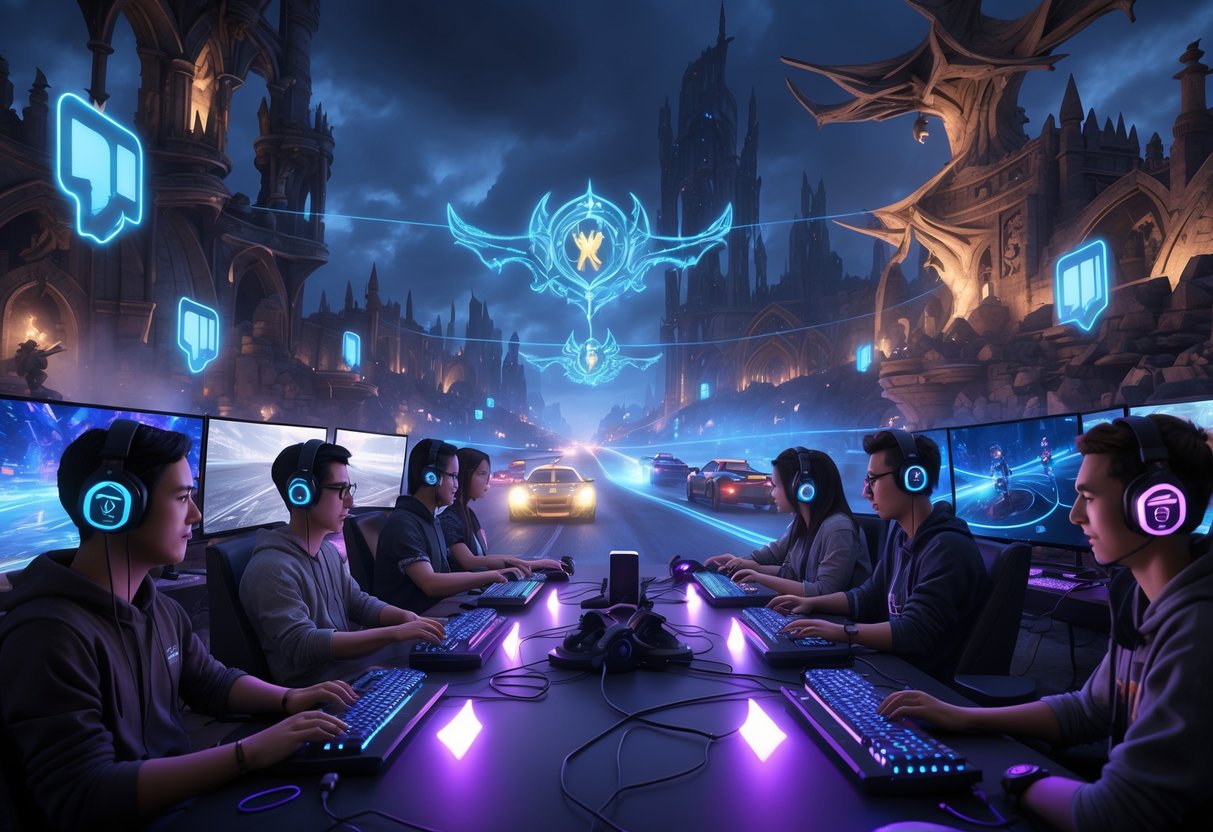
Racing streams pull in both veterans and newbies, creating a lively community around competitive events. GGG keeps running Twitch drop campaigns during big races, handing out exclusive cosmetics for watching official broadcasts and community streams.
Official Broadcasts & Shoutcasting
GGG’s official racing streams bring in commentary from experienced community members. These broadcasts cover major flashback races and signature events every league.
Shoutcasters break down strategies as they happen. They explain skill choices and route decisions, making racing easier to follow for viewers who want to learn.
Key Features of Official Streams:
- Live race commentary and breakdowns
- Player interviews between matches
- Strategy explanations for all classes
- Chat interaction with the community
Official broadcasts usually go live during peak hours for maximum viewership. It’s not uncommon to see 10,000-20,000 people watching during major races.
The commentary team mixes racing pros and content creators. That balance keeps things both insightful and entertaining.
Livestream Twitch Drop Campaigns
GGG hosts Twitch drop campaigns during races and big announcements. Lately, they’ve offered drops during special racing streams.
To get drops, you just link your Path of Exile account to Twitch on the official site. It takes a few minutes and covers you for all future campaigns.
How Twitch Drops Work:
- Watch eligible streams for a set time (usually 3 hours)
- Drops show up in your Twitch inventory
- Claim them through Twitch
- Items land on your game account within a day
Past drops included exclusive helmet attachments and portal effects. Some campaigns even gave out currency rewards for early league racers.
Heads up: Not every Path of Exile 2 streamer can give drops. Always check the official campaign page to see which channels are eligible.
Drop campaigns usually last 1-2 weeks during big events. It’s smart to watch early, since server issues sometimes pop up near the end.
Community Guides and Guilds
The racing community puts out tons of guides, from basic mechanics to advanced strategies. Discord servers act as the main place to share builds and talk meta shifts.
Big racing guilds often stream their practice runs. Watching these gives you insight into high-level prep and team play for group events.
Essential Community Resources:
- Build guides for every race format
- Route optimisation videos and maps
- Discord servers for live discussion
- Practice groups for league prep
Plenty of racers share their strategies after events wrap up. This open attitude helps newcomers learn fast.
Guild recruitment often happens through these streams. Teams look for players who know the basics and can communicate well.
The most active communities keep the conversation going all year. They speculate about future changes and plan ahead for the next big race.
Comparisons to Previous Path of Exile Races
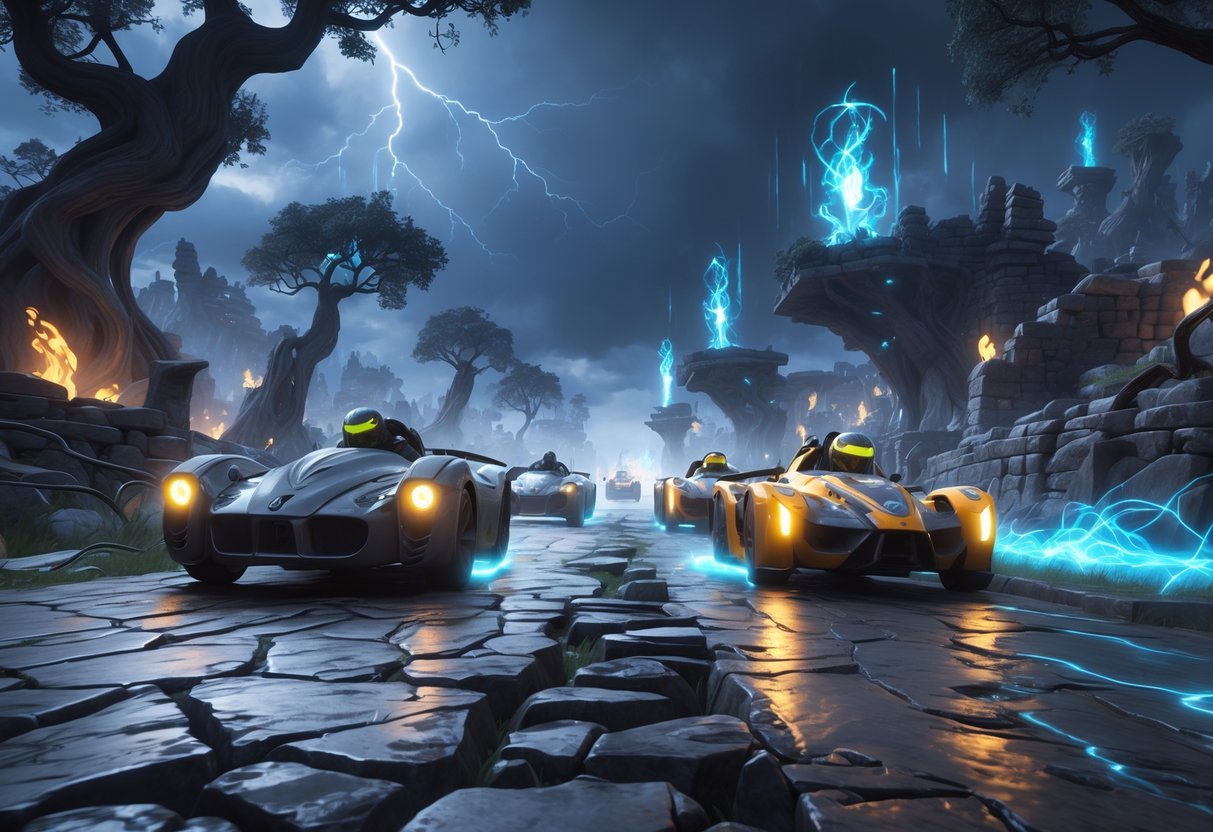
Path of Exile 2 races stick to the core competitive format, but the gameplay and rewards have changed a lot. The main goal is still to finish objectives first, but how you get there feels totally new.
Historical Race Formats
Classic Path of Exile races used all sorts of formats. Signature races lasted 1-3 hours and focused on gaining experience. Endless Ledge events dropped the normal story altogether.
Descent races gave players pre-made areas with unique rewards. These usually ran for 30 minutes to 2 hours.
The Demigod’s Dominance races were monthly. Winners got exclusive unique items as trophies. Party play and wild modifiers were common.
Season-long competitions stretched over weeks. Players earned points in lots of short races, and ladders tracked the best performers.
Most races used hardcore rules—if you died, you were out. Some had turbo mode with faster monsters, while others used blood magic so you spent health instead of mana.
Returning and New Features in Path of Exile 2
Solo Self-Found (SSF) is back as the standard. You can’t trade or get help, so the field is much more even.
The fixed layout system is brand new. Old races used random maps, but now you can memorize the best route to Doryani in Act 3.
Skill gems work differently now. Instead of socketing gems in gear, you put them straight on your hotbar as full skills.
Death penalties are still tough—a one-minute freeze if you die. Demigod item rewards remain, but now they’re split by class, not overall rank.
Cross-platform racing is a first. Console and PC players all compete for the same prizes. Before, it was just PC.
The prize pool now goes beyond virtual items. The March 2025 races, for example, will give an Alienware laptop to the winner.
Frequently Asked Questions
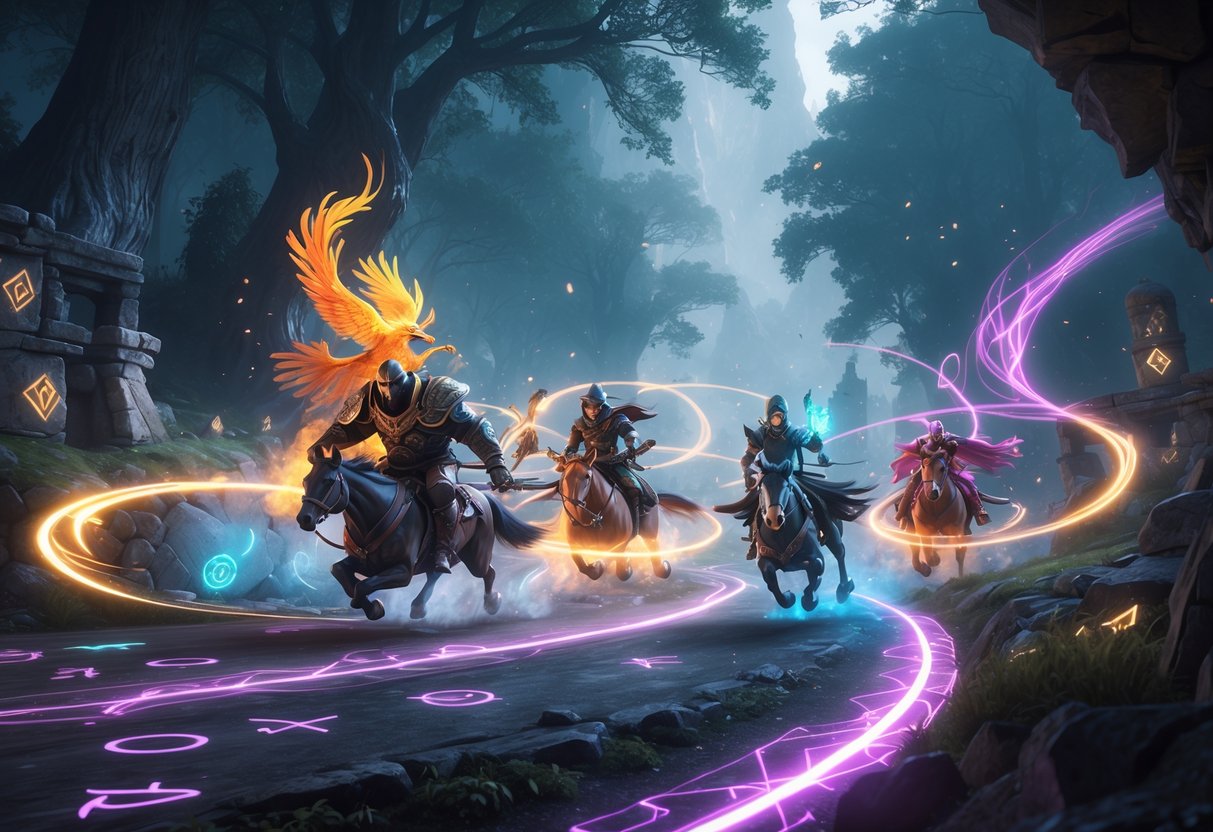
Path of Exile 2 racing sticks to Solo Self-Found rules, features several race formats with different goals, and hands out exclusive Demigod rewards to the top six classes.
What are the basic rules for participating in Path of Exile 2 races?
Path of Exile 2 races use Solo Self-Found Standard rules. You can’t trade or get outside help.
Character names need to follow the Terms of Use. If you pick an inappropriate name, you’ll get disqualified. Same goes for throwaway streaming accounts.
Game file mods are banned. Even small tweaks, like removing ultrawide black bars, can get you disqualified and banned.
GGG staff and alpha testers don’t join races. These events are for regular players.
Death penalties are active. If you die, you’re stuck for a minute before you can play again.
Could you guide me through the different types of races available in Path of Exile 2?
Right now, Path of Exile 2 features Boss Kill Race events. The goal is simple: reach Act 3 and beat Doryani as fast as possible.
Fixed layout races use set maps. There’s no RNG for map generation—it’s all about skill and efficiency.
All racers start at the same time. You spawn in, but you can’t move until the official countdown ends.
Future race types might add new goals. Grinding Gear Games plans to expand racing with more challenges and rewards.
How does ranking work in Path of Exile 2 racing events?
Rankings go by how fast you finish the main objective. The fastest Doryani kill for each character class wins that category.
Six classes compete separately: Ranger, Sorceress, Witch, Monk, Warrior, and Mercenary. That means six winners per race.
Skilled players can win more than once. If you’re good with multiple classes, you can grab rewards in several categories.
Rankings focus on speed only. There aren’t any bonus points or extra objectives.
What tips can you offer newcomers aiming to succeed in Path of Exile 2 races?
Practice fixed layouts a lot. Since maps don’t change, memorizing the best route saves real time.
Plan your path before the race. Think about skill points, gear upgrades, and flask use from start to finish.
Pick a build that’s good for racing. Not every build works for speed. Aim for something fast, reliable, and self-sufficient.
Start as soon as the race opens. Don’t miss the timer and lose precious seconds.
Play safe—dying costs you a full minute. That freeze can end your shot at winning.
Are there any unique rewards for winning races in Path of Exile 2?
If you win, you get Demigod’s Virtue items. These are special rewards you can’t pick up just by playing the regular game.
Each race hands out six Demigod’s Virtue items. The fastest player in each of the six character classes grabs one.
Grinding Gear Games also wants to roll out a full Demigod armour set in future races. They plan to include weapons and every armour piece.
Rewards land in Remove-Only stash tabs. You can equip them, show them off, trade with others, or even turn them into microtransactions using the /convertracereward command.
These items stick around as permanent trophies. They’re a cool way to show off your racing success in Path of Exile 2’s competitive scene.
How frequently are racing events held in Path of Exile 2?
The first three races kick off weekly in March 2025. Race 1 starts on March 2nd at 11:00 AM PST. The next two races follow on March 9th and March 16th.
Future race scheduling depends on community response. Grinding Gear Games will probably tweak the schedule based on how many people join in and what players have to say.
Racing events aren’t just one-off competitions—they’re shaping up to be a regular feature in Path of Exile 2. You can expect races to pop up pretty often as part of the game’s competitive scene.
Check your Path of Exile account for local times. When you log into the game client, you’ll see race dates in your own timezone.

